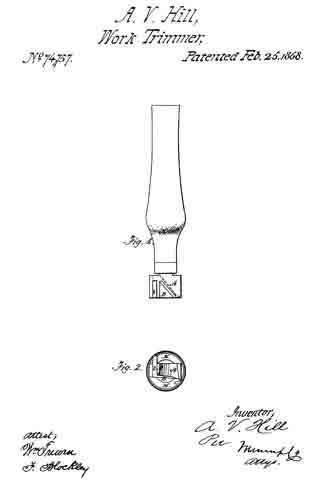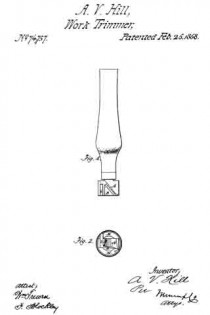
| PLEASE NOTE: The images presented on this page are of low resolution and, as a result, will not print out very well. If you wish to have higher resolution files then you may purchase them for only $2.95 per patent by using the "Buy Now" button below. All purchases are via PayPal. These files have all been cleaned up and digitally enhanced and are therefore suitable for printing, publication or framing. Each zip package contains all the images below (some packages may contain more), and purchased files can be downloaded immediately. |
United States Patent Office.
A. V. HILL, OF LIMESTONE, NEW YORK.
Letters Patent No. 74,757, dated February 25, 1868; antedated February 12, 1868.
_________________
IMPROVED WORK-TRIMMER FOR BOOTS AND SHOES.
_________________
The Schedule referred to in these Letters Patent and making part of the same.
_________________
TO ALL WHOM IT MAY CONCERN:
Be it known that I, A. V. HILL, of Limestone, in the county of Cattarangus, and State of New York, have invented a new and improved Work-Trimmer; and I do hereby declare that the following is a full, clear, and exact description thereof, which will enable others skilled in the art to make and use the same, reference being had to the accompanying drawings, forming part of this specfiication.
This invention relates to an improved work-trimmer used chiefly in making ladies’ boots and shoes; and consists in a blade, of trapezoidal form, having a rectangular shank, bent at right angles to the blade, inserted in a slotted head. In the accompanying drawings —
Figure 1 is a top view, and
Figure 2 an end view of my improved trimmer.
Similar letters of reference indicate like parts.
A is the slotted head set in the socket in handle H. The trapezoidal blade B is provided with a rectangular shank b, bent to it at right angles, and held adjustably in the slotted head A. A small lip at c serves as a guard.
In trimming work with any ordinary trimmer, the tool has to he worked from the body By applying the guard, c between the sole and upper, and drawing to the body, the blade pares the sole and cuts the welt-edge without any risk of cutting the upper, and with very much less exertion on the part of the workman.
What I claim as new, and desire to secure by Letters Patent, is —
1. The guard c, when applied to a work-trimmer, in manner and for the purposes substantially as described.
2. The blade B, fitted adjustably into a head, A, by the shank b, as herein set forth, and for the purposes substantially as described.
A. V. HILL.
Witnesses:
SHEP. L. VIBBARD,
FRANK COOK.


